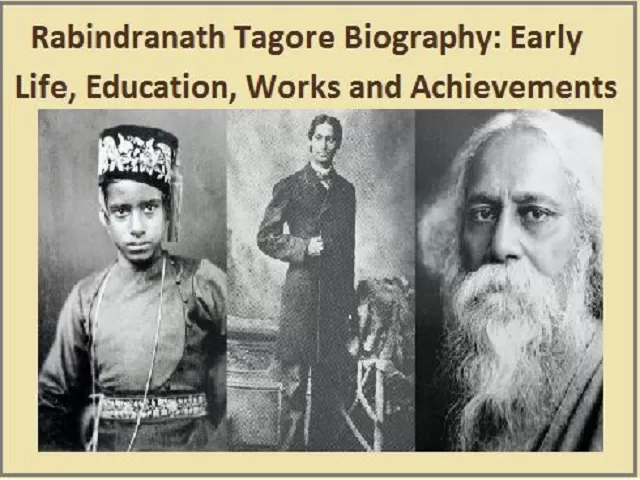Rabindranath Tagore Jayanti 2023: The birth anniversary of Rabindranath Tagore is observed on May 7, according to the Gregorian calendar but according to the Bengali calendar, he was born on the 25th day of Boishakh month. So, in West Bengal, his birthday, as per the Bengali calendar, is being celebrated this year on 9 May. In the article below, learn all about Tagore's early life, his family, education, career and more.
Rabindranath Tagore's birth anniversary is also known as Pochishe Boishakh. He was born in a rich Brahmin family in Kolkata (Calcutta) and was the youngest sibling in his family.
| Born: 7 May, 1861 Place of Birth: Calcutta, British India Penname: Bhanu Singha Thakur (Bhonita) Father: Debendranath Tagore Mother: Sarada Devi Spouse: Mrinalini Devi Children: Renuka Tagore, Shamindranath Tagore, Meera Tagore, Rathindranath Tagore, and Madhurilata Tagore Died: 7 August, 1941 Place of Death: Calcutta, British India Profession: Writer, song composer, playwright, essayist, painter Language: Bengali, English Award: Nobel Prize in Literature (1913) |
Let us tell you that Rabindranath Tagore was a multi-talented personality with a great desire to learn new things. His contributions to literature, music and several other works are unforgettable. People not only in West Bengal but also in the whole of India remember him and his contributions on his birth anniversary. Even in 1913, he was awarded the most prestigious Nobel Prize for his great contribution to Indian literature. Do you know that he was the first person from Asia to receive this award? We can't forget that he is the person who composed the National Anthem of India.
Rabindranath Tagore: Early life and Childhood Days
He was born on 7 May, 1861, to Debendranath Tagore and Sarada Devi in the Jorasanko mansion, which is the ancestral home of the Tagore family in Kolkata (Calcutta). Among his siblings, he was the youngest. He lost his mother when he was very young, his father was a traveler, and so he was mostly raised by his servants and maids. At a very young age, he was part of the Bengal Renaissance, and his family also took active participation in it. At the age of 8, he started writing poems and by the age of sixteen, he also started composing artworks and started publishing his poems under the pseudonym Bhanusimha. In 1877, he wrote the short story 'Bhikharini' and, in 1882, the collection of poems 'Sandhya Sangit'.
He was influenced by the classical poetry of Kalidasa and started writing his own classical poems. His sister, Swarnakumari, was a well-known novelist. In 1873, he toured with his father for several months and gained knowledge on several subjects. He learned Sikhism when he stayed at Amritsar and wrote around six poems and many articles on the religion.
Rabindranath Tagore: Education
His traditional education began in Brighton, East Sussex, England, at a public school. In 1878, he went to England to become a barrister to fulfill his father's wish. He was not much interested in school learning and later he joined University College in London to learn law but he dropped this and learned various works of Shakespeare on his own. He also learned the essence of English, Irish and Scottish literature and music. He returned to India and married Mrinalini Devi.
Rabindranath Tagore: Established Shantiniketan
His father bought a huge land for meditation and named it Shantiniketan. Debendranath Tagore founded an 'Ashram' in 1863. In 1901, Rabindranath Tagore established an open-air school. It was a prayer hall with marble flooring and was named 'The Mandir'. It was also named 'Patha Bhavana' and started with only five students. Classes here were held under trees and followed the traditional Guru-Shishya method of teaching. This trend of teaching revived the ancient method of teaching, which proved beneficial when compared with the modernised method. Unfortunately, his wife and two children died and he left alone. At that time, he was very disturbed. In the meantime, his works started growing and became more popular among Bengali as well as foreign readers. In 1913, he gained recognition, was awarded the prestigious Nobel Prize in Literature, and became Asia's first Nobel Laureate. Shantiniketan is now a famous University town in West Bengal.
Let us tell you that Rabindranath Tagore envisioned a centre of learning which would have the best of both the east and the west. He established the Visva Bharati University in West Bengal. It consists of two campuses, one at Shantiniketan and the other at Sriniketan. Sriniketan focuses on agriculture, adult education, village, cottage industries, and handicrafts.
Rabindranath Tagore: Literary Works
Japajog: Published in 1929, His novel is a compelling take on marital rape.
Nastanirh: Published in 1901. This novel is about relationships and love, both requited and unrequited.
Ghare Baire: Published in 1916. It is a story about a married woman constricted in her household trying to find her own identity.
Gora: In the 1880s, it is an expansive, exhaustive, and extremely relevant novel that deals with several themes like religion, gender, feminism, and also tradition against modernity.
Chokher Bali: In 1903, a novel which consists of various facets of relationships.
His short stories are Bhikarini, Kabuliwala, Kshudita Pashan, Atottju, Haimanti and Musalmanir Golpo etc.
Poems are Balaka, Purobi, Sonar Tori and Gitanjali.
No doubt he has changed the dimensions of Bengali literature as it was earlier viewed. Many countries have even erected statues to pay tribute to the legendary writer. Around five museums are dedicated to Tagore, of which three are situated in India and the remaining two in Bangladesh.
He spent his last years in severe pain and even in 1937, he went into a comatose condition. After a lot of suffering, he died on August 7, 1941, in the Jorasanko mansion where he was brought up.
Mahatma Gandhi Biography: Family, History, Movements, and Facts
